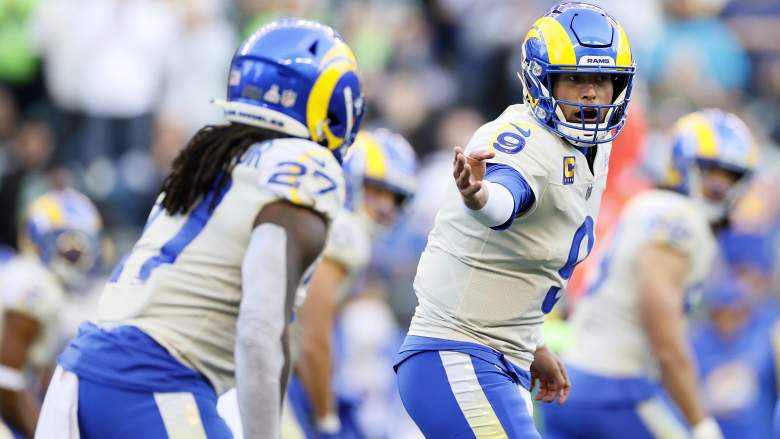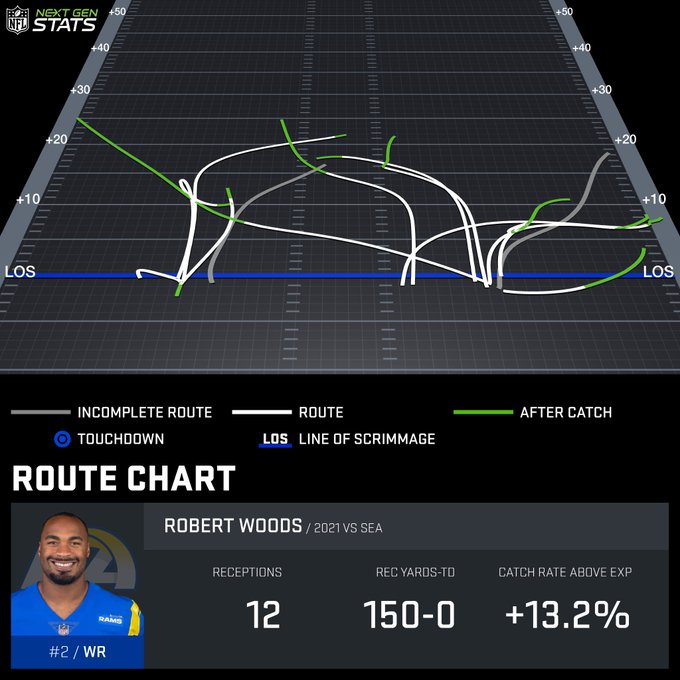
Getty Matthew Stafford calls for a motion during the Rams' Thursday, October 7, road win at Seattle.
The Los Angeles Rams picked apart the Seattle Seahawks‘ pass defense with 358 aerial yards on Thursday, October 7, in front of the “12th Man” at Lumen Field.
But 165 of that yardage came from the same concept.
Noted by Film and Analysis expert Ted Nguyen of The Athletic on the morning of Tuesday, October 12, the Rams operated from the same package against the Seahawks seven times — and Matthew Stafford went 5-of-7 passing and averaged 33 yards a completion running this look.
What was the concept? The Rams call it “Swiss.”
How the ‘Swiss’ Worked
To understand “Swiss” as head coach Sean McVay coined it per Nguyen, here’s how the play is best described pre-snap:
- The concept can operate as an empty formation. Against Seattle, Stafford is by himself while the running back Darrell Henderson is lined up as an inside wide receiver.
- Tight end Tyler Higbee comprises as the sixth member of the line of scrimmage on offense, but can block a defensive end for a second before taking off on a route.
- Meanwhile, the rest of the receivers are lined up in a bunch formation.
Nguyen caught the Rams running this same concept in the TNF contest…and the Seahawks had no answer for it.
Nguyen points out that some of the routes in this look include the “take-off” route, which was ran by DeSean Jackson. That route can resemble a stop-and-go route, except Jackson can streak inside. Cooper Kupp goes diagonal inside, or what’s called the “special” route. Nguyen wrote “this is an alert route, so Stafford would only throw this route against certain looks or peek at it after the snap.” That route is additionally pointed out here via Yaya Dubin of CBS.
The other routes in this route tree? A “skinny” that was executed by Robert Woods on this play and a “coin pivot” by Higbee, which is essentially a hitch route that can go seven yards before Higbee turns inside.
Next Gen Stats provided this graphic of how successful this look went once Woods got involved.
Chris B. Brown of Smart Football pinpointed to how Woods was most effective on the skinny dig that “Swiss” allows him to do.
Pete Carroll admitted his team struggled defending that four-wide attack from the mind of McVay.
“There were four or five plays in that game that were all, basically, the same concept,” Carroll told reporters after the loss. “Not the same play as it was different routes and formations as well as different coverages. When it came to the moment of truth, we have to execute better, and we didn’t get it done.”
Another reason why this scheme was so effective? It’s designed to counter and attack Cover 3 — which is the famed Seahawks’ coverage that dates back to their “Legion of Boom” days.
Rams Legend Kurt Warner Points Out ‘Chunk Play’ by Stafford & Woods
One more man who broke down what the Rams did? A Rams legend: Kurt Warner.
The 2000 Super Bowl champion took a dive into Stafford and the Rams’ play on his show “Study Ball.” Near the 8:40 mark, Warner explains one “chunk play” via a Stafford and Woods connection that worked off the empty “Swiss” look. Woods creates the most separation by running what Warner called a “shallow” route inside.
“We get a great chunk throw off of a simple read — understanding what you’re doing, understand who you’re attacking on a particular play and you get a big play right there,” Warner said.
More of Warner’s breakdown can be viewed below.

